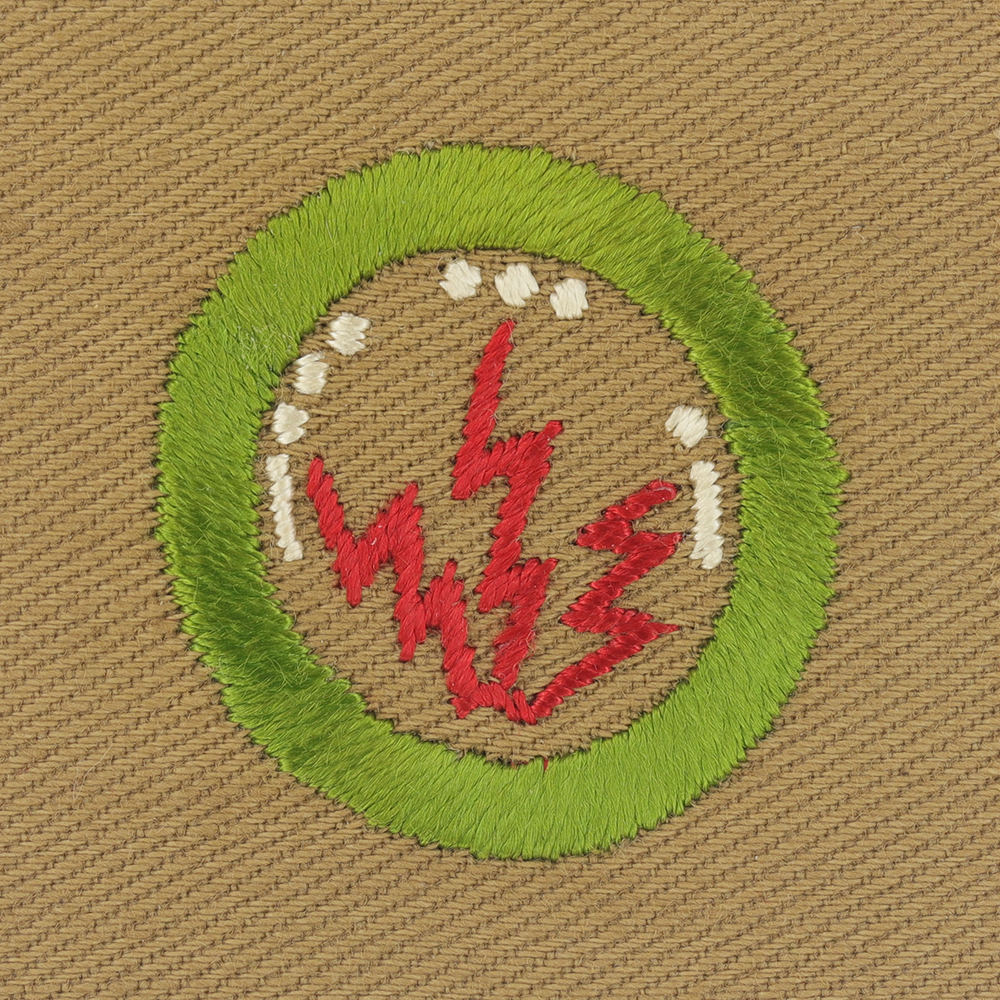
Fig. 1: Radio-AT1-Front
- Cloth: Heavyweight tan right twill
- Embroidery: Silk continuous
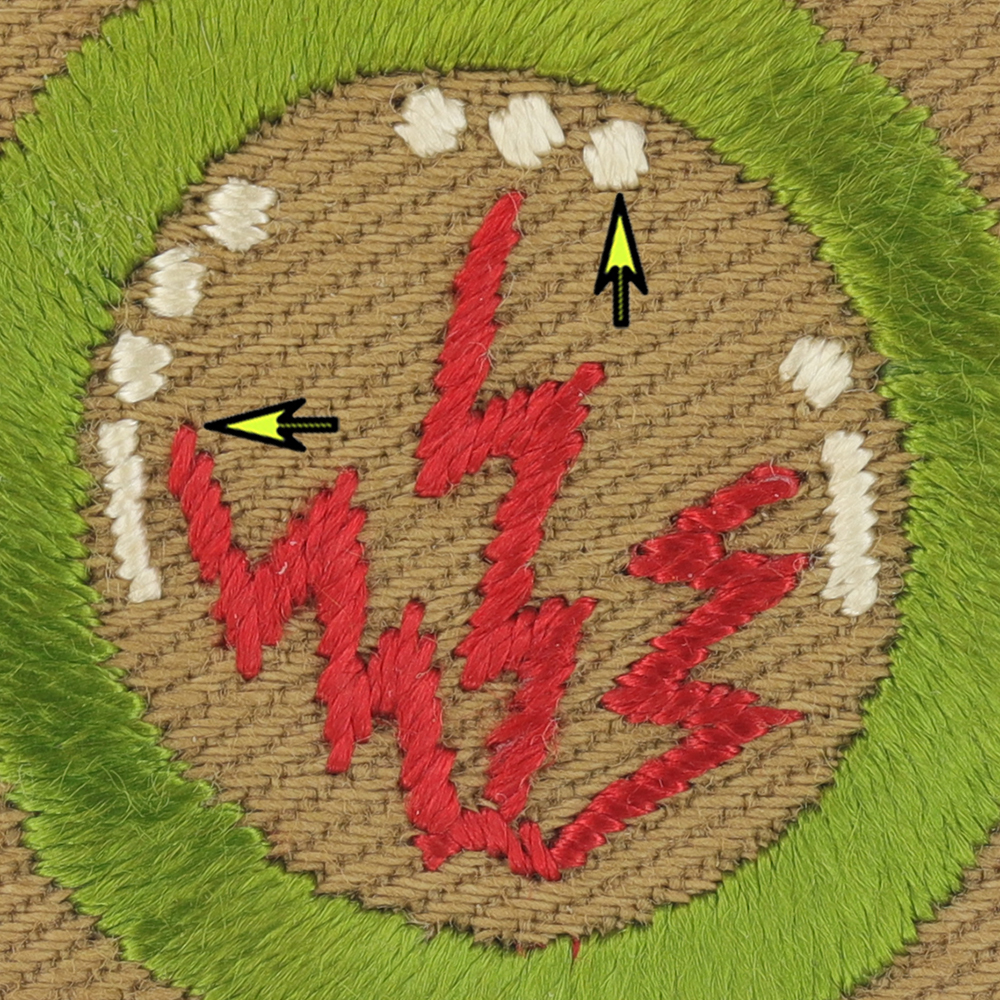
Fig. 2: Radio-AT1-Magnified
- Design: Three lighting bolts, top of left red lighting bolt even with top of left white dash, SOS dots/dashes, center dots vertical embroidery
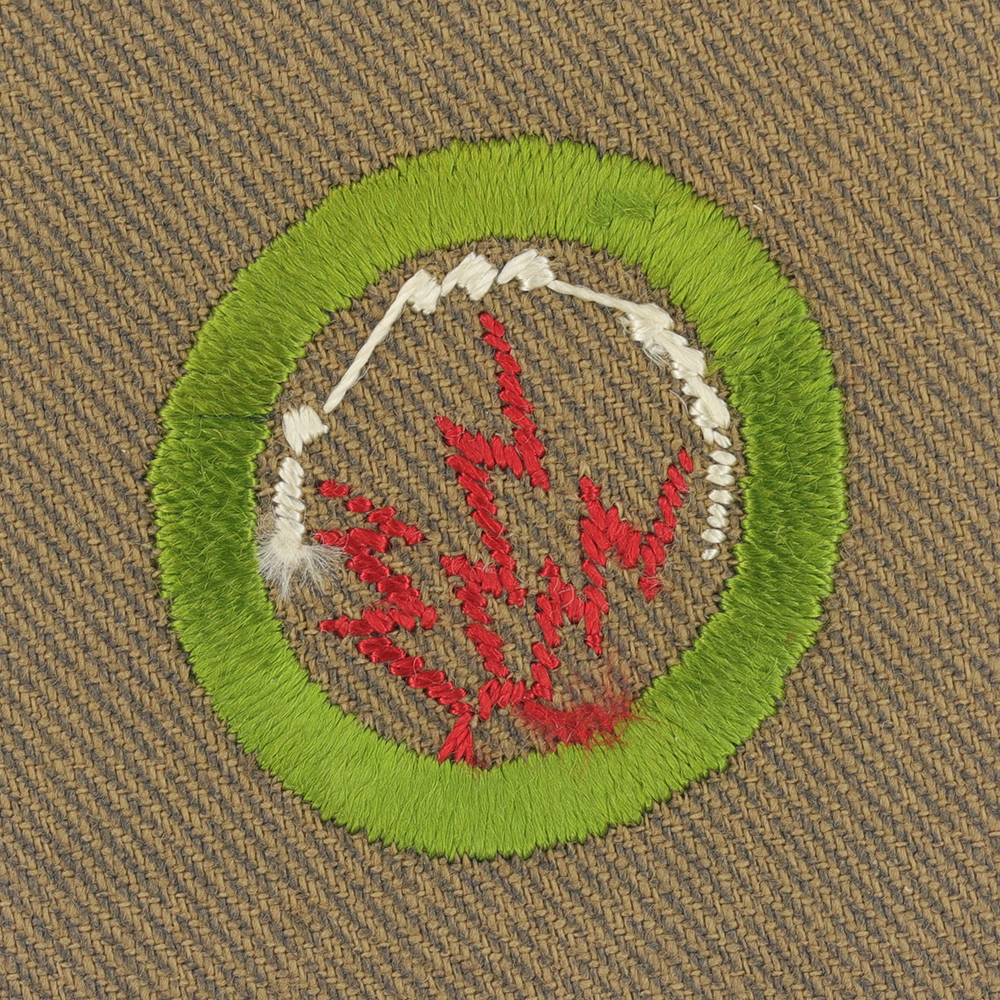
Fig. 3: Radio-AT1-Reverse
- Back: Black imprint
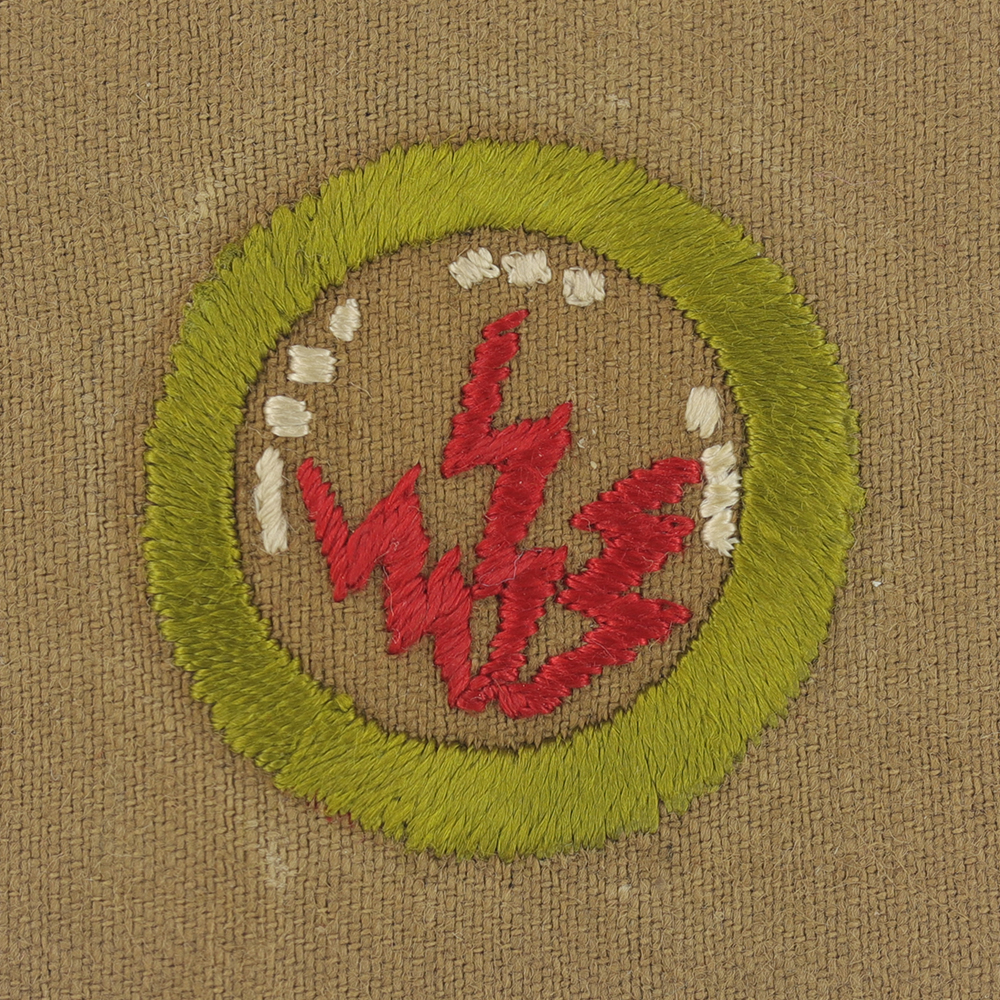
Fig. 4: Radio-AT1-error3-front
- Manufacturing error: Type 3 error; twill back
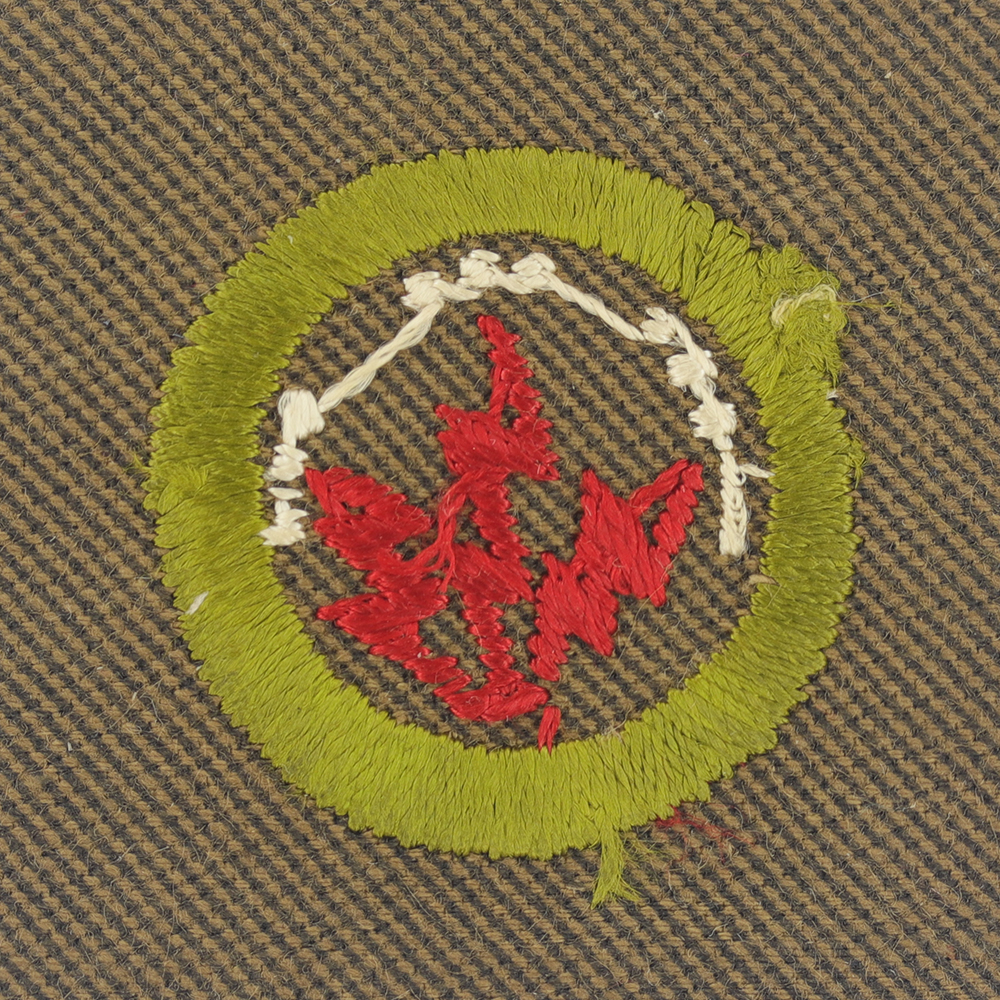
Fig. 5: Radio-AT1-error3-reverse
- Back: Black imprint
Item Name: Radio 1922 - 1933
Item ID: Radio-AT1
Collector Rating: 1
Pamphlets Used to Earn this Badge
Requirements January 1924 until May 1924
1. Be able to receive and send correctly not less than ten words a minute.
2. Know the correct form for sending a message.
3. Be able to tell in own words the principal laws regarding radio communication.
4. Know at least ten of the radiogram abbreviations. (Q signals.)
5. (a) Be able to name two types of detectors and explain how they work.
(b) Name five minerals used in detectors in the order of their sensitiveness.
6. Draw a diagram of a simple transmitting set, showing how the following instruments are connected: dynamo or storage battery (source of power), transformer, condenser, spark, gap, helix, key. Explain the function of each.
Requirements May 1924 until November 1927
1. Receive and send correctly not less than ten words per minute.
2. (a) Explain how to get in communication with another station.
(b) Explain how to send a message in proper form.
3. Tell in own words the principal laws and regulations regarding radio communication.
4. Demonstrate at least ten of the radiogram abbreviations (Q signals).
5. (a) Explain the purpose of a detector and adjust a crystal detector, using a buzzer to test its adjustment.
(b) Name two minerals used in crystal detectors.
6. Draw from memory, using correct symbols, a hook-up diagram of a complete vacuum tube transmitting apparatus, including generator or batteries, vacuum tube, condenser, tuning helix, key, antenna, ground, and the necessary protective devices. Describe each part of the apparatus and explain its function. Explain how to use a wave meter in connection with this transmitting apparatus to secure the proper wave length of radiation.
7. Draw from memory, using correct symbols, a hook-up diagram of a complete receiving apparatus, using a vacuum tube detector, including antenna, two-circuit tuner, detector, fixed and variable condensers, resistances, batteries, phones and ground. Describe each part of the apparatus and explain its functions.
8. Describe a vacuum tube and explain its three principal uses, namely, as detector, amplifier and oscillator.
9. Explain the difference between continuous wave, modulated or interrupted continuous wave and spark signals. Explain how each kind of signal is produced and how each kind is received.
10. Construct with your own hands a practical working receiving set and demonstrate its operation for receiving signals from a station 25 miles or more away.
11. Explain how to install an antenna, how to connect it to the sending and receiving set, how to ground it properly and how to protect it against lightning. State the Underwriters' laws for safeguarding radio apparatus.
Note--The holding of a first grade amateur license and a regular or special amateur license will exempt the holder from examination on counts 1, 2, 3 and 4. Both the operator's license and the station license must be presented before the local Court of Honor and shown to be in force at the time the badge is awarded.
Requirements January 1928 until November 1932
1. Receive and send correctly not less than five words per minute.
2. (a) Explain how and what you would transmit in order to establish communication with another station.
(b) Make up a sample radiogram including the "body" of the message.
3. Tell what the United States Radio Laws state about wave length, power, operating hours and kinds of apparatus for amateur radio stations; whether a license is necessary for all such stations; whether the operator needs a license; how one knows what call to use at an amateur station.
4. Write down five of the most important "Q" signals, and give the meaning of each.
5. Draw from memory, using correct symbols, the circuit diagram for a low power, short wave transmitting set, and describe briefly the principal pieces of apparatus required. Describe each part of the apparatus, and explain how its works. Explain how to use a wave meter in connection with transmitting apparatus to secure the proper wave length of radiation.
6. Draw from memory, using correct symbols, a wiring diagram of a complete receiving apparatus, using a vacuum tube detector, fixed and variable condensers, resistances, batteries, phones and ground. Describe each part of the apparatus and explain how it works.
7. Describe a vacuum tuber, name some of its possible uses, and show a diagram for one of them.
8. Explain the difference between continuous wave, and modulated or interrupted continuous waves.
9. Construct with his own hands a practical working receiving set, and demonstrate its operation for receiving signals from a station 25 or more miles away.
10. Explain how to install an antenna, how to connect it to the sending and receiving set, how to ground it properly and how to protect it against lightning, and power wires.
NOTE.--The holding of a first grade amateur operator's license and a regular or special amateur station license will exempt the holder from examination on counts 1, 2, 3 and 4. Both the operator's license and the station license must be presented before the local Court of Honor and shown to be in force at the time the badge is awarded.
Requirements November 1932 until May 1940
1. Receive and send correctly a message of not less than five words per minute.
2. (a) Explain how and what he would transmit in order to establish communication with another station.
(b) Make up a sample radiogram including the body of the message.
3. Tell what the United States Radio Laws state about wave length, power, operating hours and kinds of apparatus for amateur radio stations; whether a license is necessary for all such stations; whether the operator needs a license; how one knows what call to use at an amateur station.
4. Write down 10 of the most important "Q" signals, and give the meaning of each.
5. Draw from memory, using correct symbols, the circuit diagram for a low power, short wave transmitting set. Describe each part of the apparatus and explain briefly its purpose. Explain how to use a wave meter in connection with this transmitting apparatus to obtain radiation on the proper wave length.
6. Draw from memory, using correct symbols, a wiring diagram of a complete receiving set, using a vacuum tube detector, and one stage audio frequency amplifier showing all essential apparatus and including antenna and telephones. Describe each part of the apparatus and explain briefly its purpose.
7. Explain the difference between continuous waves and modulated or interrupted continuous waves.
8. Construct with his own hands a practical working receiving set and demonstrate its operations for receiving signals from a station 25 or more miles away.
9. Submit satisfactory evidence that he has located and repaired a fault in a receiving set.
10. Explain how to install an antenna, how to connect it for use on a sending and receiving set, how to ground it properly and how to protect it against lightning and power wires.
NOTE.--The holding of a first grade amateur operator's license and a regular or special amateur station license will exempt the holder from examination on counts 1, 2, 3 and 4. Both the operator's license and the station license must be presented before the local Court of Honor and shown to be in force at the time the Badge is awarded.



